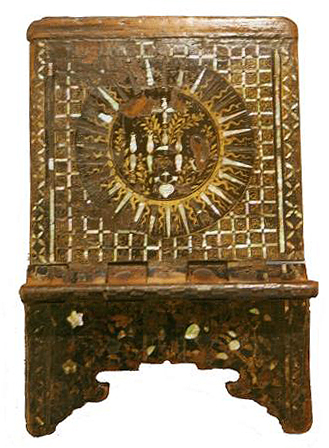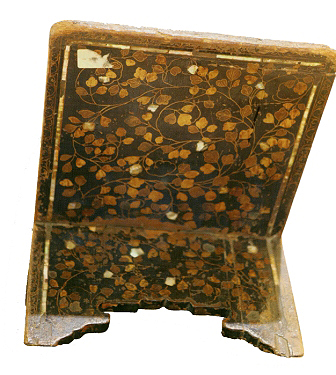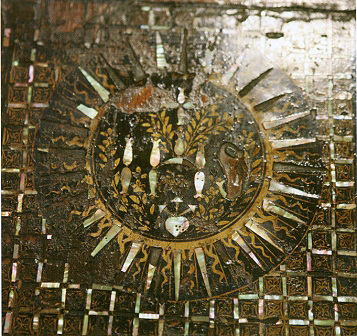The piece of the month of December 2012
ATRIL NAMBAN
Pilar Andueza Unanua
Chair of Navarrese Heritage and Art
The Town Hall of Tudela has a namban lectern which, as a historical document, testifies, among many other aspects, to the commercial and cultural relations between East and West at the end of the 16th century and the beginning of the following century. It is also worth noting the exceptional nature of this piece, as there are very few pieces of furniture of this type subject known in Spain. Examples include those from the convent of Agustinas and the church of Santiago el Real, former Jesuit convent of San Pedro and San Pablo, both in Medina del Campo, two examples from the monastery of Descalzas Reales in Madrid, the one from the church of Santa Cruz de Écija or the one belonging to the church of Santa María de los Corporales in Daroca. However, the piece from Tudela is aesthetically poorer, lacks metal corner pieces and is in a worse state of preservation.
This is an altar lectern, scissor-shaped and folding, intended for the placement of an open book in a stable manner that allowed its correct reading in the development of liturgical functions. The boards that form it are cut in its lower part in the form of a mixtilinear hoop. As is usual in Namban art, it uses the lacquer technique. On its lacquered surface there is a decoration based on drawings made with gold dust and mother-of-pearl inlays. The main panel of the obverse has a grid made of fine rows of mother-of-pearl finished at the lateral ends by a border of rhombuses also made of mother-of-pearl. This decorative network is interrupted in the center by a large IHS monogram, also in mother-of-pearl, accompanied by a cross at the top and a heart with three nails, surrounded by a halo of alternately straight (mother-of-pearl) and wavy (gold paint) rays. The back of the piece presents a delicate vegetal composition composed of a vine (kuzu) with fine stems whose outline combines two golden tones, and enriched with mother-of-pearl inlays that imitate flowers.

Namban lectern. Momoyama period (1573-1616). Town hall of Tudela
Namban art, which began in the mid-16th century with the arrival of the Portuguese in Japan, was produced in that country by local artisans at the request of the Europeans, who intended it for trade in Europe. Its essence lies in the fusion of Eastern and Western cultural and artistic elements, largely introduced by the missionary work of the Jesuits, who would be followed by other orders. This hybrid character is reflected in the typological, technical, ornamental and iconographic aspects of this piece. In fact, the lectern was an imported piece of furniture modality , since the Japanese lacked books. The technique used is lacquer, a totally oriental technique, as is the vegetal ornamental repertoire, as opposed to the Jesuit IHS, which appeared for the first time in 1549 in the Spiritual Exercises of St. Ignatius of Loyola, published in Rome. This art of a mixed nature spread during the last quarter of the 16th century and the first decades of the following century, when the Japanese government began to apply a policy of rejection to everything that represented the Catholic presence in its territory. This period coincided with the so-called Momoyama period (1573-1615), when the Tudela lectern should be placed.

Namban lectern. Reverse. Momoyama period (1573-1616). Town hall of Tudela
Europe, and later America, where it would try to imitate it, greatly admired the lacquer technique that reached a great development and quality in Japan. It was not a simple technique. On the contrary, it required a great deal of meticulousness and time. For its application, a vegetable resin obtained from certain tree species, characterized by its hardness when solidified, was necessary. This element, applied on a wooden surface in successive layers, with its corresponding polishes, was also characterized by its resistance, impermeability, brightness and smooth texture and could incorporate inlays and drawings. In the case of Namban art, the so-called urushi lacquer was used. In the intermediate layers were applied ornamental repertoires made with gold powder, silver or other pigments, a technique known as maki, which could also be inlaid with mother-of-pearl, then called raden.
The Tudela lectern responds exactly to this last technique typical of Namban art. The presence of the Ignatian monogram makes us think that it was brought to Spain by a missionary of the Society of Jesus. We do not know how it ended up in the Tudela Consistory, although it is quite possible that it could be related to the exclaustration of the Jesuits in the 18th century when, with the extinction of the order, their properties were disintegrated.

Namban lectern. Detail of the Jesuit monogram
bibliography
-ÁLVARO ZAMORA, M.I., and IBAÑEZ FERNÁNDEZ, J., "Arte para los jesuitas: el atril Namban conservado en la iglesia de Santa María de los Corporales de Daroca (Zaragoza) in FERNÁNDEZ GRACIA, R. (coord.), Pvlchrum. Scripta Varia in honores Mª Concepción García Gainza, Pamplona, Gobierno de Navarra, 2011, pp. 69-77.
-BARLÉS BÁGUENA, E. and ALMAZÁN TOMAS, V.D., Cerezos, lilies, chrysanthemums and pines and the beauty of the seasons in Japanese art. Collection of oriental art Federico Torralba, Zaragoza, Centro Joaquín Roncal, 2008.
-FERNÁNDEZ MARTÍN, M.M., "Two new works of Namban art in Seville", laboratory de Arte, 19, 2006, pp. 495-502.
-GARCÍA SANZ A., AND JORDAN GSCHWEND, A. "Vía Orientalis: Objects from the Far East in the Monastery of the Descalzas Reales", Reales Sitios, 138, pp. 169-206.
-LORAC-GERBAUD, A., L'art du laque, Paris, Dessain et Tolra, 1973.
-MOLA, A and MARTÍNEZ SHAW, C. (curators),Oriente en Palacio. Tesoros exóticos en las colecciones reales españolas, Madrid, Patrimonio Nacional, 2003.
-MORALES MARTÍNEZ, A.J., Filipinas puerta de Oriente. From Legazpi to Malaspina, Madrid, SEACEX, 2003.
